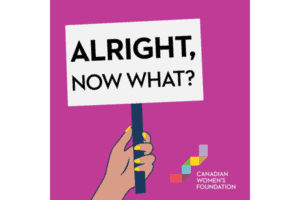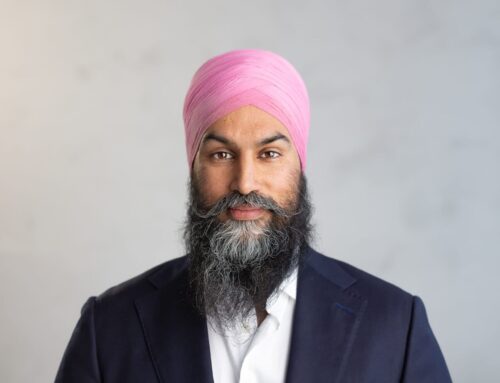 The 2022 Federal Budget says that 44% of its investments are gender neutral, 42% benefit men more than women, and just 14% benefit women more than men. What this all means can be a bit confusing. Why should we look at the budget with a critical lens, and can it really move the needle on gender justice? Ann Decter, Senior Director of Community Initiatives and Policy at the Canadian Women’s Foundation, provides helpful explanations, starting with the basics: what, why, and how.
The 2022 Federal Budget says that 44% of its investments are gender neutral, 42% benefit men more than women, and just 14% benefit women more than men. What this all means can be a bit confusing. Why should we look at the budget with a critical lens, and can it really move the needle on gender justice? Ann Decter, Senior Director of Community Initiatives and Policy at the Canadian Women’s Foundation, provides helpful explanations, starting with the basics: what, why, and how.
In her work at the Foundation, Ann focuses on a transformative intersectional response to the gendered economic impacts of the pandemic as well as on advancing social enterprise in the women’s sector. Ann joined the Foundation in 2018 after a decade as Director of Policy and Advocacy at YWCA Canada, where she founded a women’s housing advocacy campaign that led to the commitment of 25% of Canada’s National Housing Strategy to programs and services for women and girls.
Watch “How Feminist is the federal budget” on the Canadian Women’s Foundation’s YouTube channel. In this panel, cohosted by the Foundation and Oxfam Canada, feminist leaders provide an enlightening analysis of what the budget does and doesn’t achieve for the goal of gender justice.
Transcript
00:00:00 Andrea
Hi, I’m Andrea from the Canadian Women’s Foundation.
Childcare, gender-based violence, housing – these are some of the issues named in the latest federal budget announcement.
Why should we look at the budget with a critical lens? And can it actually move the needle on gender justice?
00:00:18 Andrea
Welcome to Alright, Now What?, a podcast of the Canadian Women’s Foundation. We put an intersectional feminist lens on stories that make you wonder “Why is this still happening?” We explore systemic roots and strategies for change that will move us closer to the goal of gender justice.
The work of the Canadian Women’s Foundation and our partners takes place on traditional First Nations, Métis, and Inuit territories. We are grateful for the opportunity to meet and work on this land. However, we recognize that land acknowledgements are not enough. We need to pursue truth, reconciliation, decolonization, and allyship in an ongoing effort to make right with all our relations.
00:01:01 Andrea
The announcement of the 2022 federal budget is a big deal.
The gender analysis that accompanies the budget says that 44% of its investments are gender neutral, 42% benefit men more than women and just 14% benefit women more than men.
If you’re like me and you’re no policy specialist, what this all means can be a bit confusing. Ann Decter, Senior Director of Community Initiatives and Policy at the Canadian Women’s Foundation is who I often look to for helpful explanations, starting with the basics- what, why and how?
00:01:37 Ann
The federal government has a major role to play in advancing gender justice and in addressing the intersecting inequalities to ensure that when we talk about gender justice, we’re talking about including everyone.
The federal government is the nation’s largest funder of social justice initiatives, and it’s also the largest employer. They also have a responsibility to uphold the equality provisions in the Charter of Rights. So, no matter how slow they are to get there, sooner or later they do have to get there.
Another thing is that the federal government can launch and fund national programs. For example, last year’s announcement of action on National Child Care, that will work to bridge the gender gap and improve lives of parents of all genders and families. They can also induce all of the provinces and territories to invest as well. And a recent example like that of national child care and not have to be constantly reaching back to talk about the adoption of Medicare, which has brought health care to everyone in the country.
00:02:39 Andrea
I’m no political science major, so you’ve got to carry me through the political process.
How did the government get to this funding announcement and what would be next now that it happened? How is this spending actually going to happen?
00:02:52 Ann
It’s a bit of a mystery this year on how the government actually arrived at this particular budget because it’s such an assortment of approaches, kind of bundled together. A little bit here, a little bit there. Kind of pulling back on some things, but stepping forward on others, rather than an obviously cohesive strategy which we’ve seen more in the past. Certainly the last federal budget was we’re going to spend, we’re going to spend to deal with what’s going on in the country, and these are the ways we’re going to do it. Here, there’s a lot of mixed signals. On the other hand, we’re not living in what could really be described as a predictable time. The budget would have been in process long before there was the invasion of Ukraine, for example, the pandemic has been really, you know there’s so many different ways to respond- is it done? Is it increasing? Has it changed? What do we need to put in and what impacts is it having?
In general, budgets are drawn up by the Federal Finance department and they’re based on requests received from all ministries and departments, so requests would have been coming from all over. They’re under the direction of the Prime Minister’s office. They can draw on previous budgets and we see some of that in this budget because last year made a lot of multi-year commitments and sometimes they just restate those multi-year commitments. Election promises would also have impacted this budget, especially the most recent election, promises that were made by the Liberal Party in the course of that.
This budget is also impacted by the agreement that was made between the Liberals and the NDP, and we see that in their dental care provisions that are there, they’re starting moving on dental care for children under the age of 12. But it is means-tested, so it’s for families with maximum income of $90,000 a year or less.
How’s this going to get actually spent? Some of the things that we’ve looked most closely at. They’re not going to be spent this year. They’re spent over a number of years. That’s really typical of federal budgets.
Sometimes it’s moving funding forward, for example, in housing the National Co-Investment Fund which is the biggest fund of the National Housing Strategy. There’s no new money, but they’re moving $2.9 billion forward from future years into earlier time. You know, as we’ve all heard over and over again we have a housing crisis in this country. You can see it anywhere you go really. And the government has made some moves to try and address that.
00:05:20 Andrea
We know that there’s lots of gender justice gains that we haven’t yet known and badly need, as well as losing some gains that we’ve had over the last 30 years. So what do you feel that’s really promising about the government’s budget today that you feel really excited about or you feel like, yeah, this is what we needed to see and what might be missing from it?
00:05:42 Ann
They’re kind of doing both those things at the same time. They’re both promising and worrisome at the same time.
Two big gender equality, gender justice initiatives are the continuing development of the national child care system that we saw very big announcements on last year and over the course of the last year, we’ve seen agreements signed with all of the provinces and territories, which a lot of people were nervous at the time that that part of it wouldn’t happen, but that’s in place. And the other one is a national action plan on ending gender-based violence.
So, both of these are mentioned in the budget with fairly significant funding in the hundreds of millions, not the billions, which is probably what’s needed for them, but there are major concerns around whether the funding commitment is really enough.
For the National Action Plan on Gender-based Violence, there’s a commitment of about $540,000,000 over 5 years. One concern is that in the current year, they’re only going to spend $2,000,000 of that which seems really tiny. It’s mostly going to be spent in years 3, 4 and 5. There’s a little bit of security around that as long as the NDP Liberal agreement holds, then this government will still be in power for at least years three and four, but there is some concern that it’s so much in the future.
And the purpose of that money, it’s really directed to the provinces and territories. And the conversations we’ve had a little bit about it since the announcement is really indicated that will be used to help the provinces and territories get ready for a national action plan, and also perhaps to entice them to sign agreements now that the government’s been through the experience of signing agreements around childcare. They have a little more experience with that and what it takes to do it.
The other is $625 million for early learning and childcare infrastructure fund. So one of the concerns that had followed the announcements last year in the signing of the agreements was that there’s going to be a whole bunch of new spaces, and there’s 86,000 promised in Ontario alone. But how are they going to get built? How will that get funded? So, this fund is to help with the actual expansion of childcare centres themselves so that the physical infrastructure is there to support the expansion of the system, which is great.
Again, that might not be enough, and we know that there’s staffing shortages in childcare that are very difficult and critical at this time. We really need workforce strategies across the country on that, the low wages in childcare are a big part of the issue and we don’t really see any funding that’s directed to those.
That’s the pluses, there are some things that are missing.
One that we really expected to hear something on is the silence on care work and the care economy. So the deficiencies in long term care were very obvious during the pandemic, that were all over the news. This is where especially at the beginning of the pandemic, the contagion really raged and a lot of people died. So, it’s a very much a gendered area. Not only that, older people in long term care, the older it gets, the more it bounces over towards women, but also this is very much a gendered workforce.
Women are the vast majority of workers in those homes, and it’s a large presence of Black, racialized and migrant women. It’s precarious employment, without benefits. All of this impacted during the pandemic on the functioning of the system, but it also of course impacts on the women who are actually doing the work.
Very hopeful and still working on trying to get the federal government to lead a strategy around this, in particular for better jobs, for decent work in the care economy. They have been calling for briefs on this, so perhaps it’s to come, but the complete silence in this budget is a little unnerving.
00:09:48 Andrea
What’s one thing that the individual listener hearing this information, hearing the pitfalls and the promises of this budget, what can we do? What should we do to be able to promote the goal of gender justice, knowing that there are things, it’s a mixed bag?
00:10:04 Ann
The most important thing is that we continue to encourage the government to go in the direction of addressing these kinds of issues. There is some pressure, certainly for just a general reduction in spending. It’s been like 30 years since we’ve had some major advances in social infrastructure like the creation of a national childcare. We really want the government to stay the course. We don’t want reckless spending, of course, but these are smart investments that will bring returns and really, shore up gender equality, perhaps even advance it.
We’ve seen women return to the workforce in pretty good numbers, except for in the hospitality sector, where again we know they’re not good jobs, so there’s a lot of talk about work shortages, labor shortages, and what we really need there is decent jobs that people can afford to do.
So, what can you say locally?
I would say you know if you want specific actions. Get to know your MP. Talk to them about the issues that matter to you. If that seems a little bit of a stretch, I mean they’re there and if you know if you’re shy to talk to the MP themselves, they will have staff in the office and if you’re calling every once in a while to say, I’d like to know more what you’re doing on childcare or really concerns me the state of our long-term care. They’ll note that. It amps up the attention that’s paid to the issue.
Another thing you could do is engage locally with a group that’s working on an issue that you are particularly care about. I know, I guess I come from advocacy. I find it exciting- every once in a while you get a breakthrough. So those are my suggestions in the direction of advocacy.
00:11:40 Andrea
Alright, now what?
In addition to the tips that Ann shared, check out How Feminist is the Federal Budget?, a panel co-hosted by the Canadian Women’s Foundation and Oxfam Canada. In this virtual event, feminist leaders provided an enlightening analysis of what the budget does and doesn’t achieve for the goal of gender justice. Watch it on the Canadian Women’s Foundation YouTube channel.
Please listen, subscribe, rate and review this podcast and share it with others. If you appreciate this content, if you want to get in on the efforts to build a gender equal Canada, please donate today and consider becoming a monthly donor. And thank you for being tireless in your support for gender justice.






